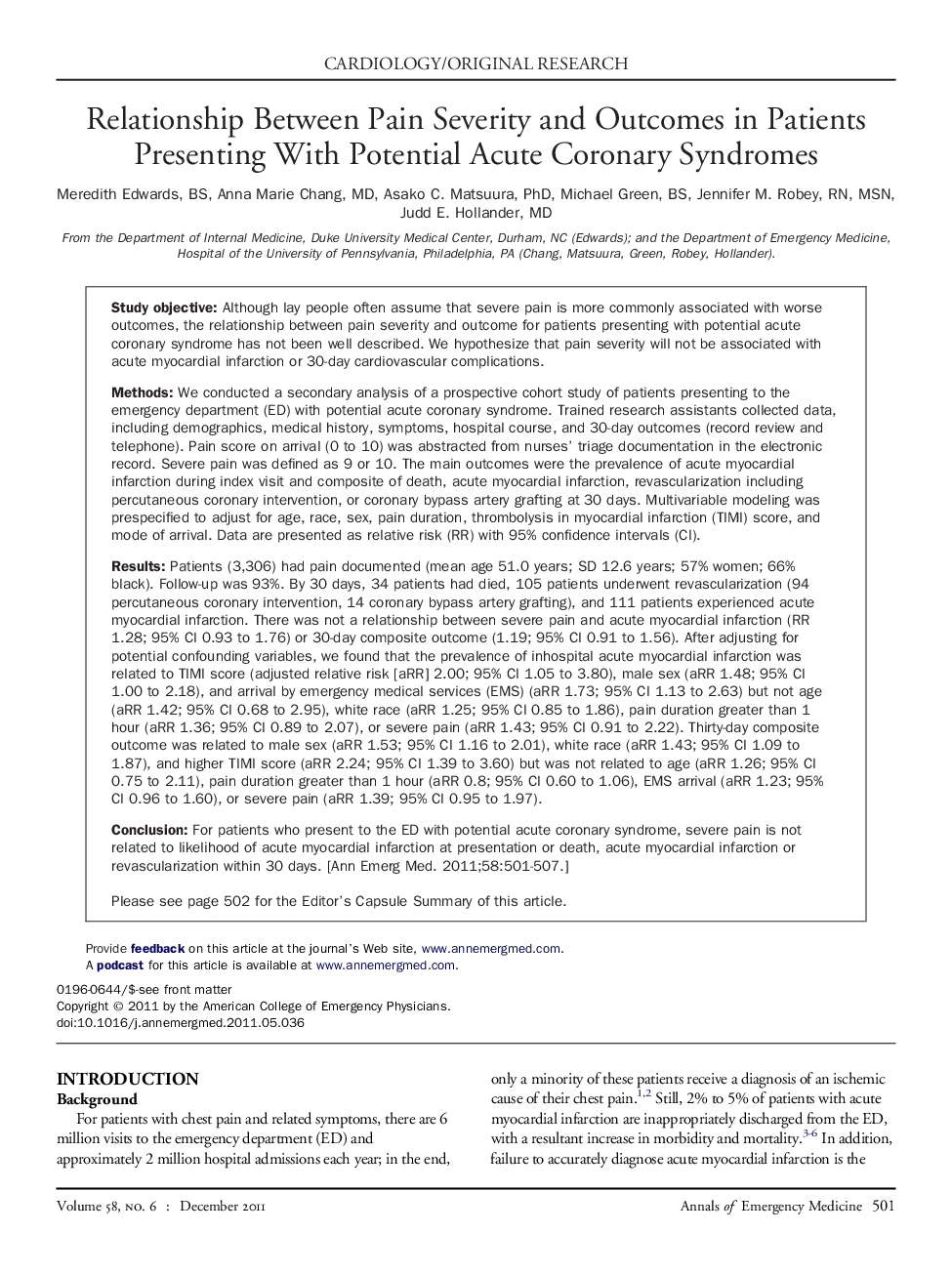| کد مقاله | کد نشریه | سال انتشار | مقاله انگلیسی | نسخه تمام متن |
|---|---|---|---|---|
| 3230500 | 1588564 | 2011 | 7 صفحه PDF | دانلود رایگان |

Study objectiveAlthough lay people often assume that severe pain is more commonly associated with worse outcomes, the relationship between pain severity and outcome for patients presenting with potential acute coronary syndrome has not been well described. We hypothesize that pain severity will not be associated with acute myocardial infarction or 30-day cardiovascular complications.MethodsWe conducted a secondary analysis of a prospective cohort study of patients presenting to the emergency department (ED) with potential acute coronary syndrome. Trained research assistants collected data, including demographics, medical history, symptoms, hospital course, and 30-day outcomes (record review and telephone). Pain score on arrival (0 to 10) was abstracted from nurses' triage documentation in the electronic record. Severe pain was defined as 9 or 10. The main outcomes were the prevalence of acute myocardial infarction during index visit and composite of death, acute myocardial infarction, revascularization including percutaneous coronary intervention, or coronary bypass artery grafting at 30 days. Multivariable modeling was prespecified to adjust for age, race, sex, pain duration, thrombolysis in myocardial infarction (TIMI) score, and mode of arrival. Data are presented as relative risk (RR) with 95% confidence intervals (CI).ResultsPatients (3,306) had pain documented (mean age 51.0 years; SD 12.6 years; 57% women; 66% black). Follow-up was 93%. By 30 days, 34 patients had died, 105 patients underwent revascularization (94 percutaneous coronary intervention, 14 coronary bypass artery grafting), and 111 patients experienced acute myocardial infarction. There was not a relationship between severe pain and acute myocardial infarction (RR 1.28; 95% CI 0.93 to 1.76) or 30-day composite outcome (1.19; 95% CI 0.91 to 1.56). After adjusting for potential confounding variables, we found that the prevalence of inhospital acute myocardial infarction was related to TIMI score (adjusted relative risk [aRR] 2.00; 95% CI 1.05 to 3.80), male sex (aRR 1.48; 95% CI 1.00 to 2.18), and arrival by emergency medical services (EMS) (aRR 1.73; 95% CI 1.13 to 2.63) but not age (aRR 1.42; 95% CI 0.68 to 2.95), white race (aRR 1.25; 95% CI 0.85 to 1.86), pain duration greater than 1 hour (aRR 1.36; 95% CI 0.89 to 2.07), or severe pain (aRR 1.43; 95% CI 0.91 to 2.22). Thirty-day composite outcome was related to male sex (aRR 1.53; 95% CI 1.16 to 2.01), white race (aRR 1.43; 95% CI 1.09 to 1.87), and higher TIMI score (aRR 2.24; 95% CI 1.39 to 3.60) but was not related to age (aRR 1.26; 95% CI 0.75 to 2.11), pain duration greater than 1 hour (aRR 0.8; 95% CI 0.60 to 1.06), EMS arrival (aRR 1.23; 95% CI 0.96 to 1.60), or severe pain (aRR 1.39; 95% CI 0.95 to 1.97).ConclusionFor patients who present to the ED with potential acute coronary syndrome, severe pain is not related to likelihood of acute myocardial infarction at presentation or death, acute myocardial infarction or revascularization within 30 days.
Journal: Annals of Emergency Medicine - Volume 58, Issue 6, December 2011, Pages 501–507